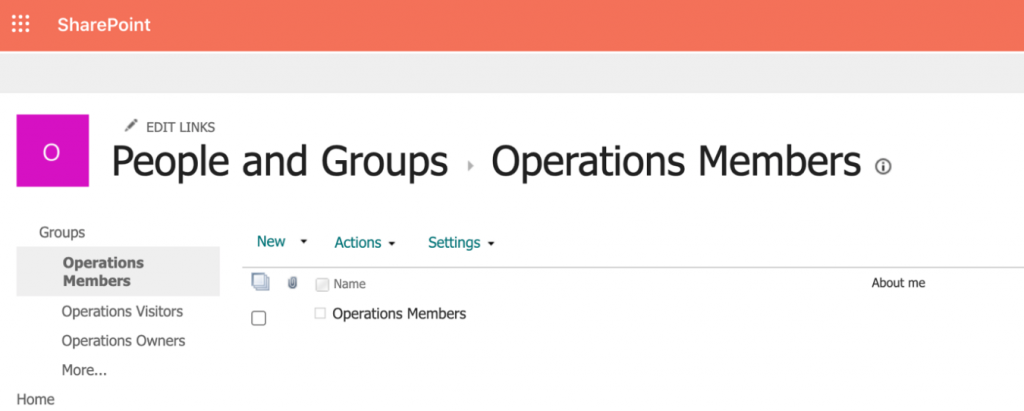
In this article, we’ll demonstrate how to create SharePoint Online Team Sites. This has stemmed from our recent blog series, How to Create a SharePoint Online Intranet, where we showed you how to create an Intranet landing page in SharePoint Online based on a Modern Communication site.
The site included a company logo and a site title. We also uploaded a custom theme to the site using the Microsoft Theme generator tool and the SharePoint Online Management shell.
We then built our landing page by adding sections and a Hero web part to make our highlighted content prominent. Finally, we added some further web parts, including a News Feed, some Quick Links, a Weather widget, and an Image Banner. Here’s how the finished page looked:

Another element to include on an Intranet Landing page is a tile grid that links to individual Share/Point Team sites. Team sites (not to be confused with Microsoft Teams) are collaborative SharePoint Online sites where groups of people can work together on shared content in Document Libraries. They differ from Communication Sites, which are informative as opposed to collaborative.
You can find more information on SharePoint Online Team sites here.
During this article we’ll show you how to:
- Create Time Sites in SharePoint Online, and assign the correct permissions to your Microsoft 365 users and groups
- Grasp the concept of Hub Sites, which allows you to “Apply common navigation, branding, and site structure across associated sites”
- Use the Audience Targeting feature to ensure that your content is only visible to authorized users and groups
- Link to your Team Sites from your Intranet landing page
Creating a SharePoint Team site
To create your new Team site, you’ll need to access the SharePoint admin center, which you can access from the Microsoft 365 Admin Center. You’ll either need to be a Global Administrator or SharePoint Administrator role.
- Once you’ve logged in, you’ll need to navigate to Admin centers > SharePoint (you may also need to click on“Show all”before you see the SharePoint admin center in the menu).

2. This will take you into the SharePoint admin center.

3. Click on Active sites, and you’ll see the list of sites that are already present within your Microsoft 365 tenant.

4. To create your new Team site, click Create. This will give you options about the sites you can create
Next, we’ll look at the choices you have by examining the available site types and when to use them.
Site types
The following site types are available within SharePoint Online.
| Team site | You typically use a Team site to share documents within a team. When you create a Team site, you’ll see a Microsoft 365 group is also set up automatically. This is the option to select to establish your new SharePoint Online site. |
| Communication site | You’ll design a Communication site to publish content to your organization to keep them informed. As Communication sites are informative as opposed to collaborative, they don’t have a Microsoft 365 group associated with them initially. |
| Other options | Under Other options, you may choose from additional templates such as Document Center, Enterprise Wiki, and Publishing Portal. |
5. The primary purpose of this page is to share documents within a team, so we need to create a Team site. Select the Team site option from the Create a site page, and we’ll see the following options for choosing the design for our site.

6. We need to complete the following information to provision our Communication site:
- Site name
- Group email address
- Site address
- Group owner
- Preferred language
You can see my setup in the following image, where I have named my new Team site ‘Operations’ and assigned myself as the Group Owner for the associated Microsoft 365 group.

7. If we drill down into Advanced settings, we can also set additional options for the site, including Sensitivity, Time zone, and the Site description. When you’re happy with your settings, click Next.

8. Next, you may add any additional owners requiring responsibility for managing the Team site, and you may also add some members to the Team site. In the example below, I’ve added one more owner and a single member to the site.

9. Now that we have completed the required fields, we can click Finish to create our new Team site.
10. This takes you back to the Active sites list in the SharePoint Admin center, and if we enter the name of our newly created site and press enter, we’ll see our site displayed as follows.

11. Clicking on the new site will display information relating to the site.

12. Under the URL section, click on the link, and this will take you to the new Team site.

Now that we have our new Team site, let’s double-check some of the permissions and group settings.
Checking the site permissions
To check the site permissions for our new Team site, we need to carry out the following steps.
- Make sure that you have the Team site page open, then click on the cogwheel at the top right of the screen and select Site permissions.

2. All SharePoint Online Team sites have three default SharePoint Online groups set up as default. These are:
- Site Owners – Members of this group have Full control
- Site Members – Members of this group have Edit permissions
- Site Visitors – Members of this group have Read permissions

3. By clicking on Advanced permission settings, we can take a more detailed look at these permissions groups.

4. For example, if we click into Operations Members, then we will see the following.

5. What this shows, is that the Operations Members Microsoft 365 group (which was created when we set up the site), has been automatically added to our Operations Members SharePoint Online group.
6. If we navigate to the Microsoft 365 Admin Center and select Groups, we can search for our Operations Microsoft 365 group.

7. Clicking to open the group enables you to view the permissions tab.

Here, we can see the created group with two Owners (who are also members by default) and one member. Members will also be in the SharePoint Online Operations Members group.
Summary
In this post, we’ve taken you to create a new SharePoint Online Team Site, which will serve as a collaborative space for an Operations Team within an organization. We demonstrated how to create the site from the SharePoint admin center, create a Microsoft 365 group and SharePoint Online permissions groups as part of this process, and access the new site from the SharePoint Admin center.
In part two of this blog series, we’ll show you how to create a Hub Site and associate the new Team site to it, add a link to your Team site on your Intranet landing page, and how to use the Audience targeting feature to ensure that your SharePoint Online users will only see content which they are authorized for.



Very pleasing to read and understand. Looking forward to part two.
Thank you.
After searching for quite a while, this is one of the best sites i’ve come across for straightforward info/training on SP online.
THANK YOU!!!! 🙂
Hi Kev, thank you so much for the kind words. It’s massively appreciated!!
Thank you for the kind words once again. Really pleased that this is useful. More to come in part 2 and 3 very soon. Anything else you’d like to see from a SharePoint point of view?
Correction, there is no part 3. Just part 2. This is a two part series.
Hi Peter, again great post. As a deep techie this is great info when customers ask me some functional SP Online questions 🙂 and build a ‘default’ branded Intranet.